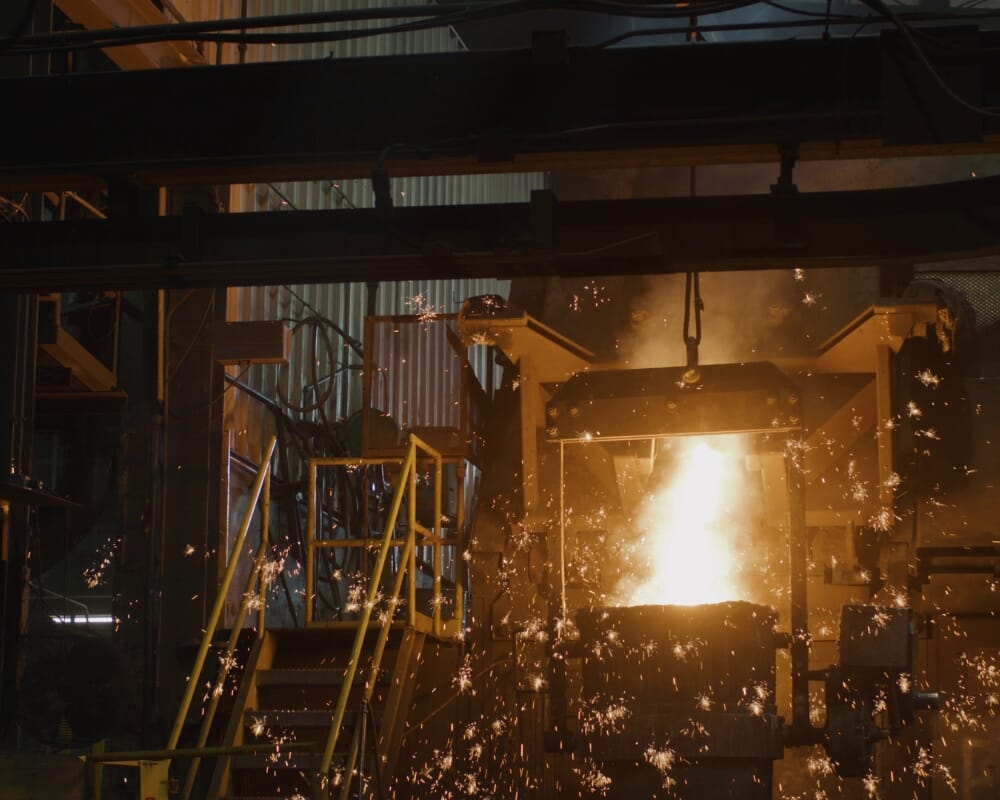
What Are Compression Ratios and What Do They Tell Us About Compressor Performance?
June 25, 2025
The Key to Air Compressor Longevity: Getting Your Bearings
July 9, 2025What’s the Difference Between Full Load and Duty Cycle? And Why Should You Care?
Kaishan USA | July 2, 2025 | Uncategorized
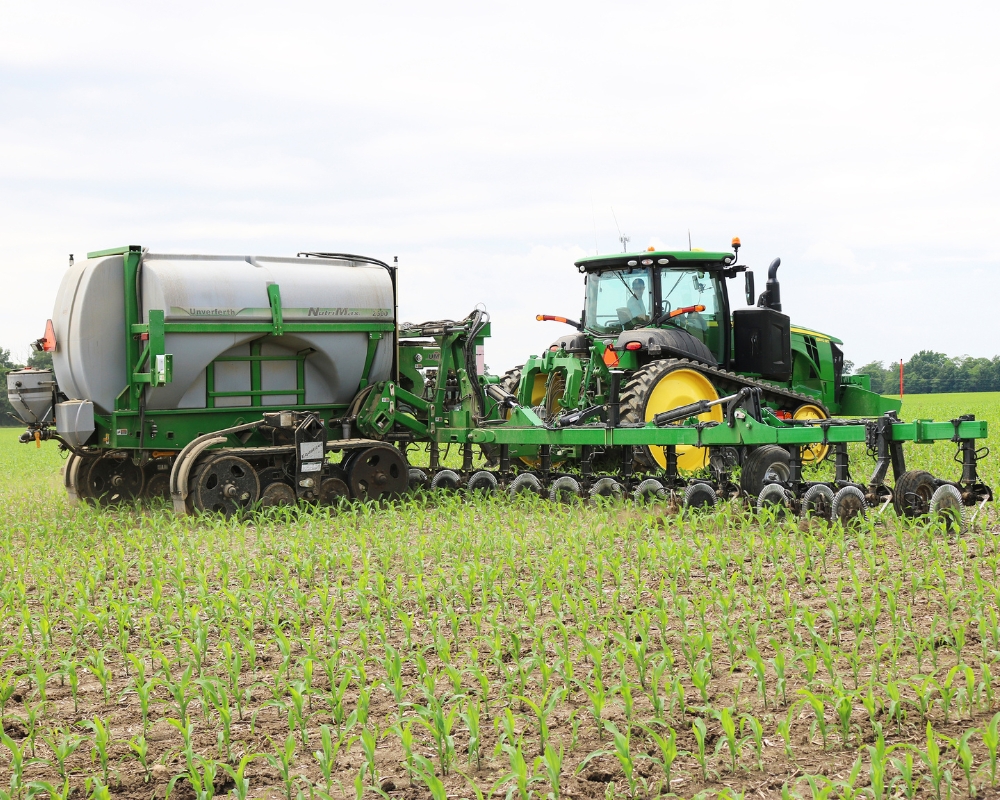
After Iowa Pump and Compressor audited base load, duty cycle and demand profile, Unverferth Manufacturing of Shell Rock, IA, achieved significant savings and increased reliability. To view the full case study and download the video, please visit the Unverferth page on our website.
There are several terms used to describe the capacity and performance of an air compressor. Phrases like full load. Compressor duty cycle. Demand profile. And trim compressors.
They each describe slightly different concepts and are essential when you are selecting and operating an air compressor.
Although you may not need to define them, failing to account for their impact can result in several problems for your compressed air system. Like overheating. Increased maintenance, resulting from wear and tear. And more frequent breakdowns.
We’ll discuss each of them in more detail, starting with full load.
Full Load
Load measures the capacity of your compressor, the maximum output. Operating at full load means your compressor is generating the full amount of compressed air it is designed to produce.
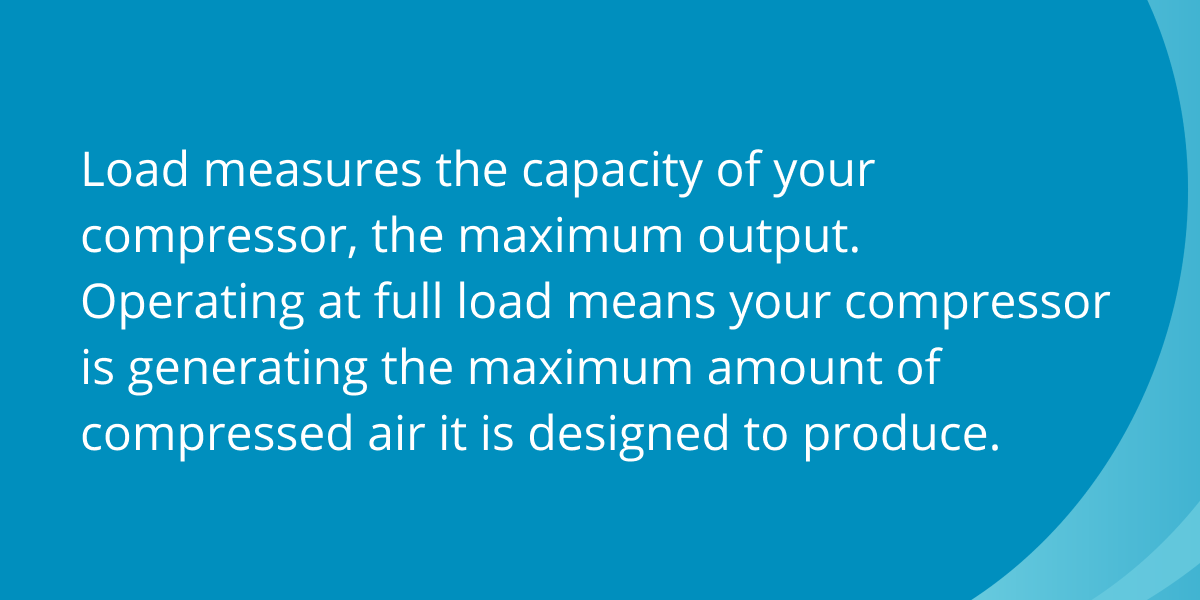
However, the inverse relationship between pressure and flow means that when you increase the pressure, you decrease the flow. And vice versa. So, when you increase the pressure, you will not get the same amount of flow as you had at the lower pressure. But, unfortunately, while you can increase flow by decreasing pressure, the gains are minimal.
Next is compressor duty cycle.
Compressor Duty Cycle
Compressor duty cycle refers to the percentage of time a compressor can safely run without overheating or experiencing excessive wear and tear. It is typically expressed as a ratio or percentage. For instance, a compressor with a 50% duty cycle is designed to run for half the time and rest for the other half.
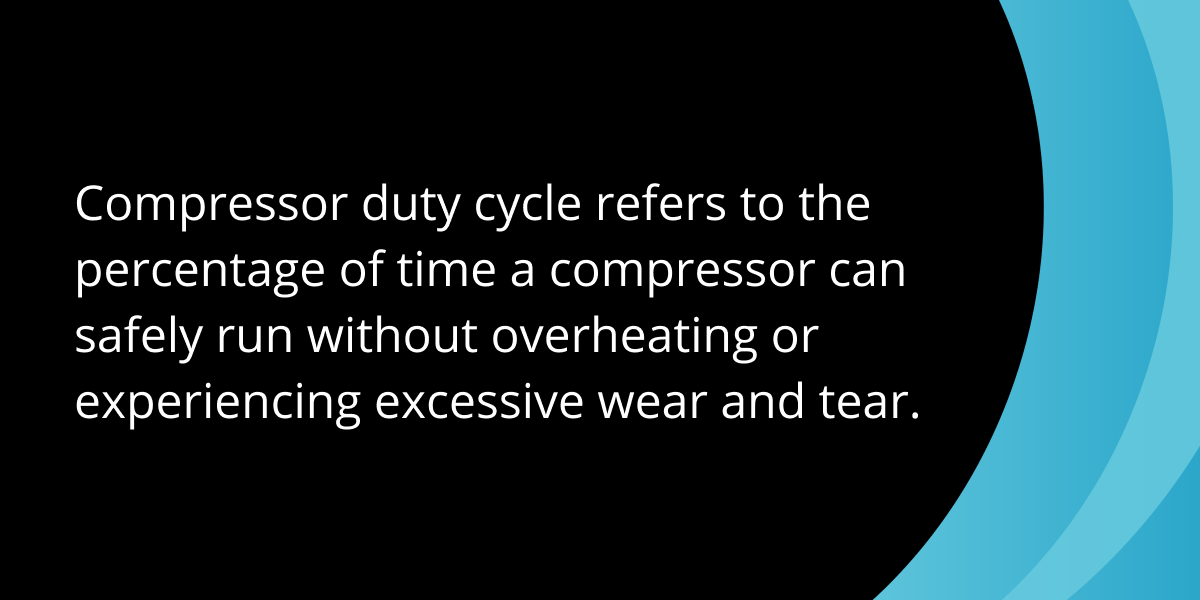
Reciprocating compressors have a low compressor duty cycle because they rely on radiant cooling and don't have an oil-cooling circuit to remove the heat of compression. As a result, they need time to cool off.
Heavy use or a high duty cycle is not recommended for reciprocating machines. They work best with intermittent or partial duty—50% duty cycle or less. That’s 30 minutes in an hour. Run a recip longer, and you risk damaging your compressor and shortening its lifespan.
On the other hand, centrifugal and rotary screw compressors have internal cooling components that enable them to maintain a 100% duty cycle. We recommend setting up your compressed air system to operate as close to 100% duty cycle as possible.
Here's why: when your compressor is running at full load, it’s running at peak efficiency. There are fewer starts and stops, which means less wear and tear on key mechanical and electrical systems. There’s also less moisture buildup.
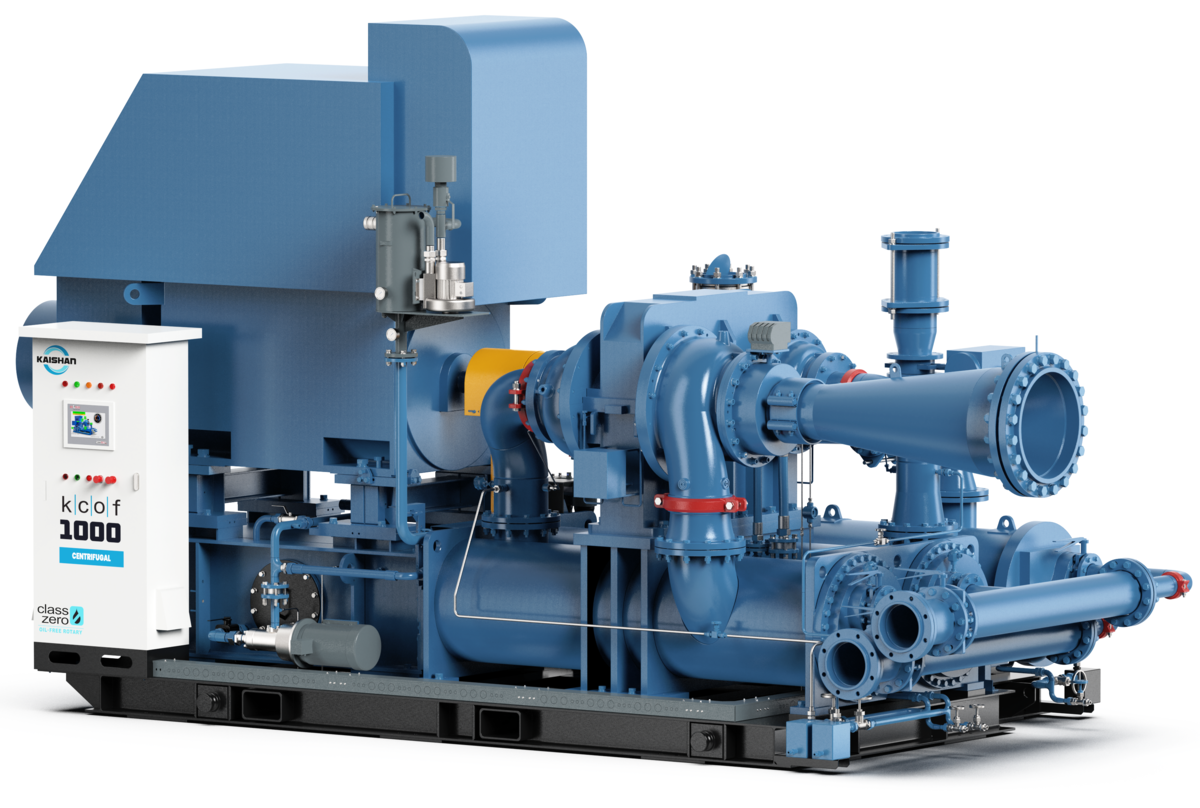
Centrifugal air compressors like our KCOF oil-free unit run best at a 100% duty cycle.
For more details on compressor duty cycle, read our blog post, “Twelve Critical Differences Between Rotary Screw and Piston Air Compressors.”
Storage
As a result of their shortened duty cycle, reciprocating compressors need storage tanks to ensure that compressed air is available during their cooling-off period. And although screw compressors do not require storage to provide continuous coverage, they do need tanks for control storage, which covers the time it takes for controls to transition from unload to load.
For more information on storage and compressed air receiver tanks, read our blog post, “A Quick Guide To Accurately Size Air Compressor Tanks.”
In addition to understanding load and compressor duty cycle, you’ll want to understand your demand profile.
Demand Profile
You’ll want to conduct a comprehensive review of your end uses to calculate the pressure and flow you need. A common mistake is to overestimate how much flow you need.
Suppose you have ten tools that all require 5 CFM of flow. You may think that means you need 50 CFM of flow. But you probably don’t. You may only need 10.
The reason is that those ten tools usually do not all work at once. Some may be in continuous use, but most are probably intermittent. Specifically:
- Intermittent-use tools are used only in short bursts of activity, such as tire inflation, tightening and fastening equipment, nail guns, impact wrenches and hammers. Many companies use reciprocating compressors for this type of application, especially when they are the sole users of compressed air in their facilities or when they are isolated from other compressed air-consuming equipment.

Applications like nail guns are generally intermittent-use tools, only used in short bursts of activity.
- Continuous uses include sanding equipment, spray painting and pneumatic controls that are in operation most of the time. Because of their 100% duty cycle, centrifugal and rotary screw air compressors are most cost-effective for continuous use applications.
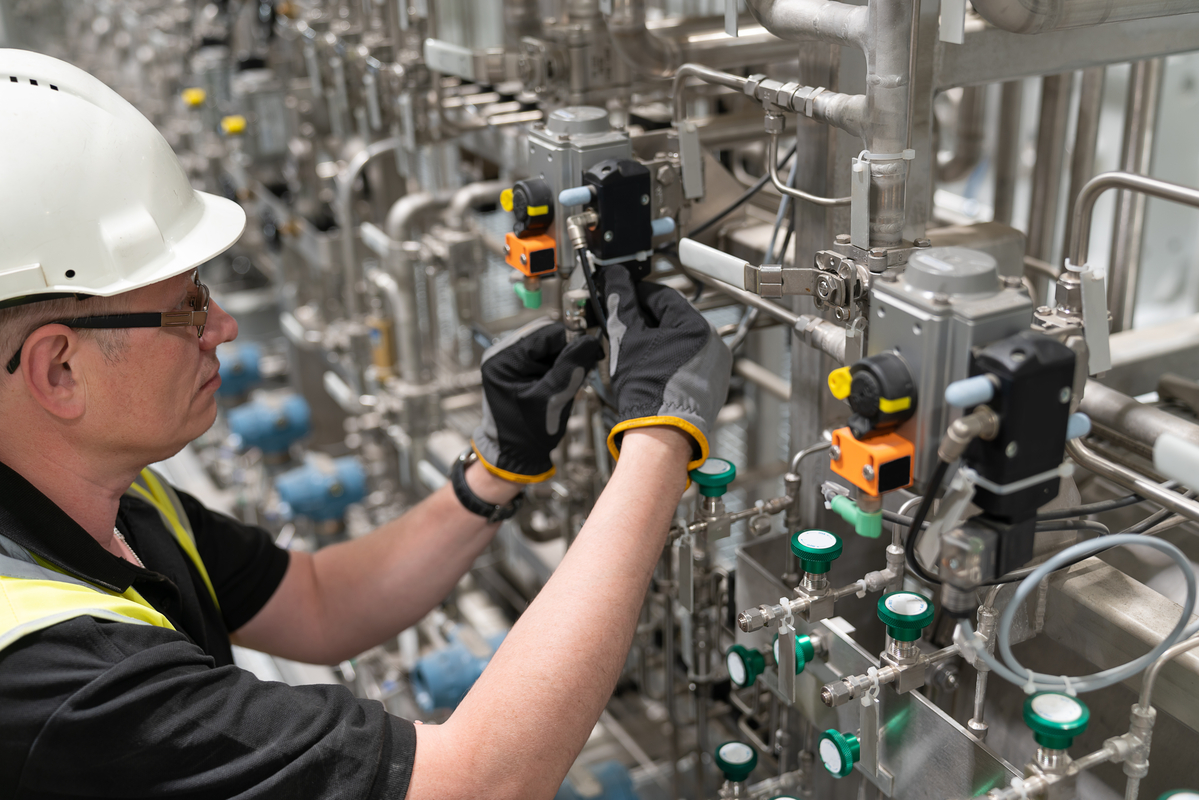
Pneumatic controls are sometimes in operation 24/7 and thus represent continuous-use applications of compressed air.
To estimate your demand profile, you’ll want to determine how much air you use throughout the day. Ask if you are using each tool or end use continuously or only sporadically. And which tools are running simultaneously?
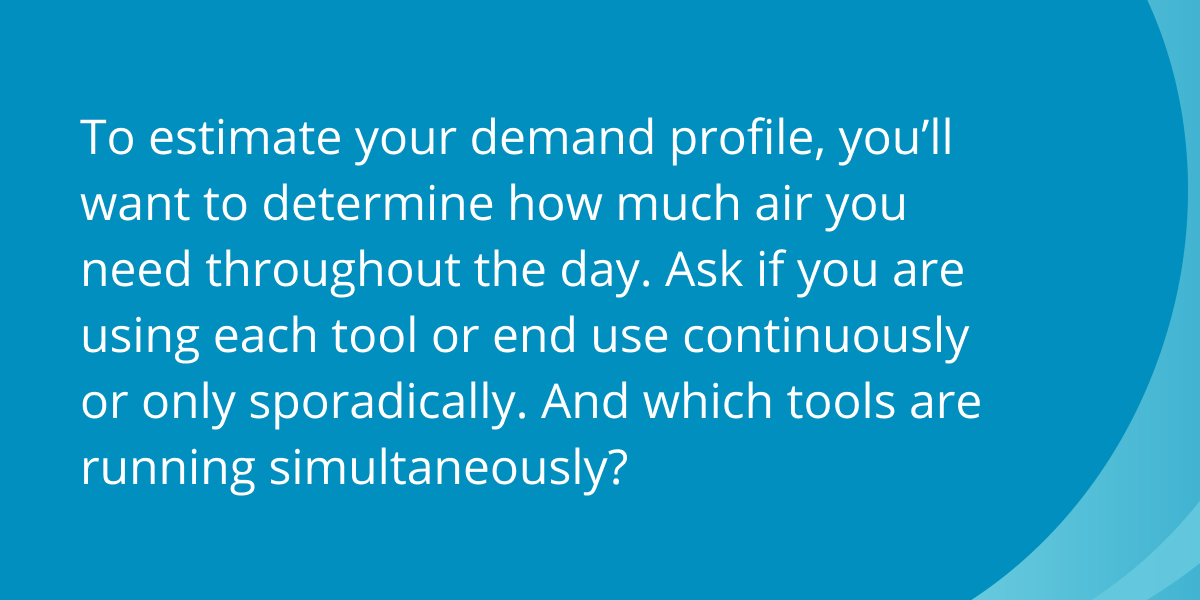
For more on utilization factor and demand profile, read our blog post, “CFM vs. PSI: What You Need To Know To Size an Air Compressor.”
You’ll also want to ask yourself how a compressor is being used. Is it a solo unit, or is it part of a more comprehensive compressed air system?
Multiple-Compressor Systems
We often encourage customers to adopt a three-compressor approach, involving base, trim and backup units.
- A base load compressor to meet your system’s minimum compressed air load. Its output does not fluctuate as demand fluctuates. Instead, it runs full bore—at 100% of capacity—or it turns off. Depending on variations in your demand, you may have more than one unit as a base load.
- A trim compressor to handle fluctuations in demand above the base unit. Since the level of flow needed will rise and fall depending on the needs of your system, centrifugal equipped with inlet guide vanes and rotary screw compressors with variable-speed drives are a natural for this application.
- A backup compressor on standby in case a base or trim unit goes offline. To fill in appropriately, it should be the same size as the base load compressor.
Configuring your compressed air system in this way virtually eliminates unplanned downtime, which, in the real world, is the biggest (and most avoidable) expense associated with your compressed air system. A highly reliable backup always waits in the wings should a base load or trim unit fail, keeping both pressure (PSIG) and flow (CFM) more consistent and reliable.
We discuss multiple compressor configurations in greater detail in our blog post, “How Energy-Efficient Air Compressors Can Reduce Your Carbon Footprint.”
The ultimate goal, of course, is to size your compressed air system correctly.
Compressor Sizing
Sizing may be the most important decision you make when you’re buying a new air compressor.
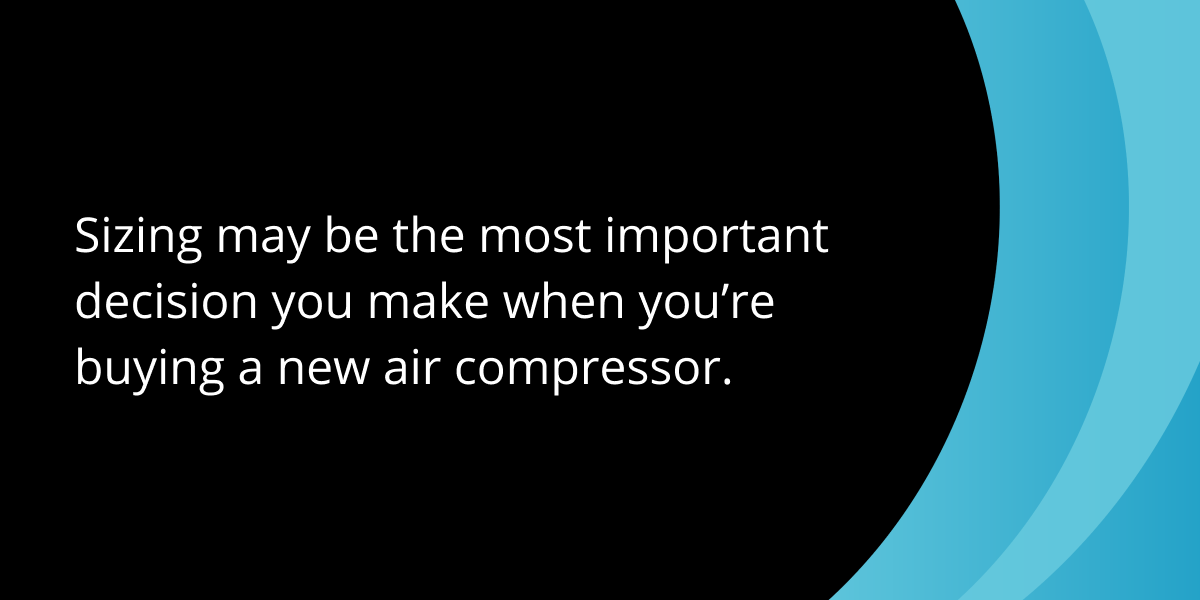
It’s more important than the type of machine, whether you’re considering a reciprocating, centrifugal, rotary vane or rotary screw air compressor.
It’s more important than your decision about the drive system, whether direct or belt-drive. Equipped with a variable-speed drive. Or whether it’s oil-lubricated or oil-free. It’s even more important than the brand you select.
The reason? Time and again, experience has shown that the most serious air compressor problems stem from mistakes in sizing or application.
With rotary screw air compressors especially, that means oversizing. Or over-buying. Trying to add more “muscle” to your system or anticipate future needs.
Too Much Is as Bad as Not Enough
It may seem counterintuitive, but with rotary screw air compressors, “too much” is almost as bad as “not enough.” So, it’s essential that you don’t oversize your system.
As mentioned previously, rotary screw air compressors are designed for a 100% duty cycle. Run them significantly less than that, and you’ll waste electricity.
More importantly, oversizing is the leading cause of rapid cycling, which causes maintenance nightmares, equipment failures and downtime.
When sizing a centrifugal compressor, we want to look at all operating conditions, specifically sizing the compressor to make sure we have adequate design flow out of the machine on the hottest day. But as with rotary screw compressors, you want to make sure not to oversize a centrifugal. Over-designing a turbo “just in case” may lead to wasting a lot of energy.
To get a better understanding of the intricacies of sizing, read our post, “Everything You Need to Know About Sizing Industrial Air Compressors for Manufacturing.” Or download our white paper, “Demystifying Air Compressor Sizing.”
The Ultimate Answer to Sizing Questions
The good news? The best way to match your demand profile and size your compressed air system correctly is to work with a trusted advisor. With the right plan, you can avoid costly downtime and machine failures.
That process usually starts with an air audit.
Air Audits Get You Off to a Good Start
Almost any company can benefit from an air audit performed by an air compressor professional. To see how companies across many industries benefited from an audit, read our blog post, “How an Air Compressor Audit Can Reduce Operating Costs.”
Our independent distributors are well-equipped to audit your system, providing on-site assistance and consultation as needed. They’re part of a nationwide network of distributors who are factory-trained air compression experts.
We partner with independent, local distributors because it's the best way to serve you. Unlike large corporate suppliers, there's no red tape. Plus, they build relationships, ensuring you get the right system, reliable service and quick access to parts when you need them most.
With factory-trained technicians and a deep understanding of industrial applications, they help maximize efficiency and minimize downtime. So, when you buy through Kaishan, you're getting more than a product—you're getting a local partner who cares about your business and wants to see it succeed.
Key Takeaways
- Understanding terms such as full load, duty cycle, demand profile and trim compressors can help you avoid problems like overheating, increased maintenance and breakdowns.
- Load measures the capacity of your compressor, the maximum output. So, operating at full load means your compressor is generating the full amount of compressed air it is designed to produce.
- Compressor duty cycle refers to the percentage of time a compressor can safely run without overheating or experiencing excessive wear and tear.
- To estimate your demand profile, you’ll want to determine how much air you need throughout the day. Ask if you are using each tool or end use continuously or only sporadically. And which tools are running simultaneously?
- Sizing may be the most important decision you make when you’re buying a new air compressor.
- Almost any company can benefit from an air audit performed by an air compressor professional.
Let Us Help
Understanding key concepts such as full load, compressor compressor duty cycle and demand profile is critical to the operation of your compressed air system and all the processes that rely on it. If you need help knowing how these concepts apply to your operation, get in touch with the experts at Kaishan. Contact us today.
Listen to the Podcast Version
Understanding Compression Ratios
Alright, welcome back to The Big Dog Podcast. I’m Jason Reed, here with Lisa Saunders, and today we’re getting into the nitty gritty—compression ratios. I know, it sounds like one of those things you only care about if you’re an engineer, but trust me, it matters for everyone running compressed air on the floor.Yeah, and honestly, I used to think compression ratio was just a fancy way to say “how much pressure you’re getting out of your compressor.” But it’s actually about comparing the discharge pressure to the atmospheric pressure coming in, right?
Exactly. So, if you’re at sea level, you’ve got more atmospheric pressure to work with. But if you’re up in Denver, for example, you gotta work your compressor harder to get the same output. That’s your compression ratio in action. And the higher that ratio, the more work your compressor’s doing—and the more power you’re burning through.
And that’s where efficiency comes in. I read that for every 2 PSI you bump up your pressure, you’re using about 1% more power. That adds up fast, especially if you’re running multiple shifts or big equipment.
Oh, for sure. I mean, back at my old shop, we thought, “Hey, let’s just crank up the pressure, get a little more punch for the tools.” Didn’t realize we were basically lighting money on fire. Our power bill shot up, and it took us way too long to figure out it was just those extra few PSI. It’s one of those lessons you only learn the hard way, I guess.
Yeah, and it’s not just about the bill, right? If you’re running at higher pressures than you need, you’re also putting more stress on your system. So, it’s not just efficiency, it’s about keeping your equipment alive longer.
Managing Heat and Boosting Efficiency
So, let’s talk about heat. Because the higher your compression ratio, the more heat you’re generating. And that’s a big deal for how long your compressor’s gonna last.Yeah, heat’s the silent killer. You don’t always see it, but it’s there, wearing out your bearings, breaking down your oil, just making everything work harder. That’s why multi-stage compression is such a game changer. Instead of doing all the work in one go, you split it up—like with Kaishan’s KRSP2. You compress a bit, cool it down, then compress again. That interstage cooling step? It’s huge for cutting down on heat and wasted energy.
I actually talked to a plant manager last month who switched to a KRSP2. He said before, they were always fighting cooling issues—shutdowns, alarms, you name it. After the switch, way fewer headaches. Maintenance dropped off, and they weren’t scrambling to fix overheating problems every week. I mean, it’s not magic, but it’s a real difference.
Yeah, and it’s not just about less heat. Two-stage compressors like the KRSP2 can give you up to 15 to 20% more flow than a single-stage of the same horsepower. That’s a big deal if you’re trying to get more out of your system without upsizing everything.
And if you add a variable speed drive to that setup, you can squeeze out even more efficiency, especially if your demand goes up and down. I think Carlisle Construction Materials got an $11,000 rebate just for upgrading to a VSD-equipped KRSP2. That’s not pocket change.
Nope, not at all. And the reliability side—less heat, less stress, more bearings in the right places—it all adds up to longer life and less downtime. That’s what you want, right? Keep the air flowing, keep the shop running.
Choosing the Right Compressor for the Job
So, here’s the big question—when do you actually need a two-stage compressor? I mean, they’re not for every shop, but there are some places where they just make sense.Yeah, like if you’re running heavy-duty tools, robotics, or anything that needs steady, high pressure—think metal presses, injection molding, or even big CNC machines. That’s where two-stage units really shine. You get more flow, more reliability, and you might even be able to downsize. Like, swap a 300 HP single-stage for a 250 HP two-stage and still get more air. That’s wild.
And the upfront cost isn’t as bad as people think. If you can go smaller, you’re not just saving on the sticker price—you’re saving on power and maintenance for years. I always tell folks, the initial cost is just a piece of the puzzle. You’ll pay for power and repairs way longer than you’ll remember what you paid for the machine.
Totally. But I do think there’s a point where you gotta call in a local pro. Like, you can read all the specs you want, but matching the right system to your shop’s needs? That’s where a factory-trained distributor or tech can really help. They know the ins and outs, and they’re not just there to sell you something—they want you to get the right fit so you’re not calling them every month with problems.
Yeah, I mean, I’m all for DIY, but when you’re talking about a system that’s gonna run your whole operation, it’s worth getting some expert eyes on it. They’ll help you figure out what you actually need, not just what looks good on paper.
Alright, I think that’s a good place to wrap it up. Compression ratios, heat, efficiency, picking the right compressor—it all matters if you want to keep your shop running smooth and your costs down. If you’re not sure what’s right for you, don’t be afraid to reach out to a local expert.
Yeah, and we’ll be back next time with more straight talk on rotary screw tech and what’s really happening on the shop floor. Lisa, always a pleasure.
You too, Jason. Thanks for listening, everybody. Catch you on the next episode of The Big Dog Podcast.
Random stat or
customer quote
textXXtext
text

